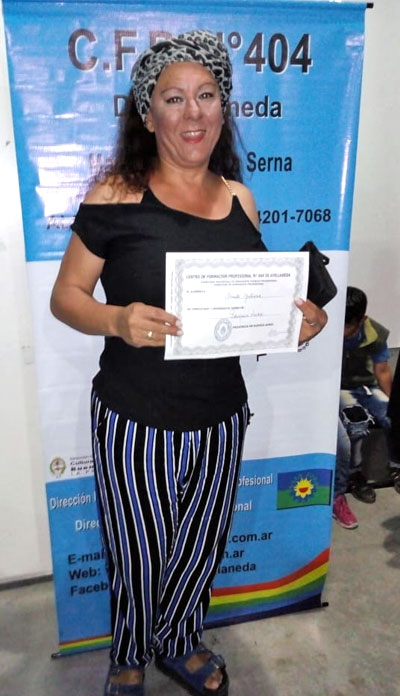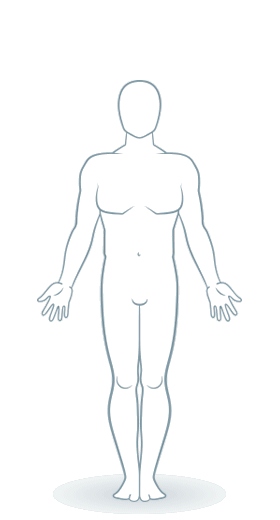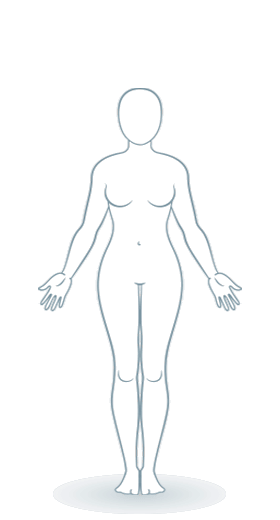

“I’m a survivor,” says Yuliana Oviedo, who lives in Avellaneda, a southern province in Buenos Aires, Argentina.She is 55 years old and 1.70 m (5 ft 7in) tall. She makes ends meet by cleaning houses, cutting, and styling hair. She suffers from chronic obstructive pulmonary disease (COPD) and she has encountered several barriers to accessing healthcare. In the 80’s, she got pumped—she got silicone injected into her breasts, hips, buttocks, and crotch. After a while, she ended up in the hospital. Doctors initially thought she had pneumonia, yet the black spots in Yuliana’s lungs were the silicone that had migrated through her body. “When I meet a transgender girl or boy, I urge them to get medical advice prior to any invasive procedure and to do some research,” she says.

Yuliana, like other transgender people, has a gender identity that does not conform to what is associated with the sex she was assigned at birth. Yuliana was assigned male at birth based on the appearance of her external genitalia, but she identifies and lives as female. Also, there are cases in which a person who was assigned female at birth, identifies and lives as male.
Transgender people, just like every human being, have the fundamental right to live fulfilled and dignified lives, to education, to health, and to employment. Trans people are part of the great human diversity. However, they still have to contend with stigma and discrimination in Latin America as they are frequently exposed to violence and harassment, living on the margin of their school, family, job, and health services.
Yuliana is finishing elementary school today. She hopes to start junior high next year. “If my health allows, I hope to major in Political Science.” She got off marijuana and cocaine, and left prostitution behind, but—as many other transgender women—she has been exposed to specific social determinants leading to a series of problems that result in an average life expectancy that ranges from 35 to 41 years old in contrast with the 75-year life expectancy of the region according to the project REDLACTRANS (Trans Women Without Borders Against Transphobia and HIV/AIDS) based on partial regional reports.
“It is unacceptable that trans people, as any other vulnerable population group, have a shorter life expectancy. In 2014, Pan American Health Organization (PAHO) member states approved the Strategy for Universal Access to Health and Universal Health Coverage. ‘Universal health’ is the foundation of a system based on the values of the right to health, equity, and solidarity. ‘Universal’ means that everyone has access and coverage to comprehensive, quality care, plus it calls to for strengthening intersectoral approaches to the social determinants of health without financial difficulties. This strategy requires both the commitment to transform the region’s health systems and a concerted effort to eliminate barriers and improve access,” PAHO’s Health Services and Access Chief Amalia del Riego said.
Historically, it had been determined that transgender people suffered from a mental health condition as there is a mismatch between their gender identity and the sex they were assigned at birth. In June, 2018, the World Health Organization (WHO) removed categories related to transgender identity from the classification of mental disorders, opting to use the term “gender dysphoria” instead. The United Nations (UN) has emphasized that “pathologization is one of the root causes of human rights violations faced by trans people.”
A reclassification made by an institution, however influential, does not guarantee a woke society. Stigmatization has a huge impact on transgender people. According to the REDLACTRANS network—a trans advocacy NGO fighting discrimination in the region since 2004— up to 77% of trans people were kicked out of their house in their childhood. One in four transgender people dropped out of junior high due to harassment by teachers and classmates. Moreover, 52% of trans people faced discrimination in health centers and hospitals. In many countries, administrative personnel, security guards, and even health professionals have not received adequate training to provide appropriate care to trans people which in turn leads to mistreatment and stigmatization. Not long ago, Yuliana remembers when a receptionist in a hospital insisted on calling her by her birth name, but a doctor allowed to change that name to “Yuliana” in her medical record.
Unfortunately, such a touching display of empathy is the exception to the rule. Most of the time, transgender people are not called by the name that matches the gender with which they self-identify. In other cases, health-care providers link being transgender with living with HIV (Human Immunodeficiency Virus) which in turn leads to greater stigmatization.
Trans people avoid early medical intervention as they have felt stigma from the initial seeking of treatment. They experience fear and most of the time they return to seek medical care too late in the course of their disease, which leads to poorer prognoses. For decades, denial of medical care has led trans people to turn to either licensed treatment in private clinics or illegal treatment as Yuliana did when she modified her body through procedures that lacked both scientific evidence and proof of safety.
Argentina, Chile, Uruguay, and Bolivia are the only countries in the region that have gender identity laws – What do they guarantee?
Source: Marcela Romero (REDLACTRANS) - Presentes Agency
Mexico, Ecuador, Colombia, Venezuela, Brazil, and Costa Rica have modified their legal framework seeking to recognize the people’s right to change their gender identity.
Source: Marcela Romero (REDLACTRANS) - Presentes Agency
Source: Marcela Romero (REDLACTRANS) - Presentes Agency
Still and all, there are indicators that the situation regarding the right to access to healthcare in Latin America is beginning to shift. Argentina, Chile, Uruguay, and Bolivia—within their federal laws—along with Costa Rica, Ecuador, Colombia, and Mexico enabled trans people to change their name without undergoing gender reassignment surgery. In both public and private hospitals in the region, transgender people can access to medical interventions that have been scientific-based assessed.
There are several procedures that help a person with gender dysphoriato increase the congruence between their gender identity and gender presentation. There is not a single formula. The treatment depends on each individual. Each person decides the possible steps in order to change their body to conform to their gender. Transgender women can choose to go through feminizing hormone therapy, which consists of taking medications to block the action of the male sex hormone testosterone while increasing the female sex hormone estrogen to induce feminine secondary sex characteristics, such as body fat redistribution, reduction of muscle mass and body hair, and breast development, among others.
| Effect | Initial | Maximum | |
|---|---|---|---|
| 1 | Body fat redistribution | 3 – 6 months |
2 – 3 years |
| 2 | Decrease in muscle mass/Strength | 3 – 6 months |
1 – 2 years |
| 3 | Skin softening/Decreased oiliness | Unknown | |
| 4 | Decreased libido | 1 – 3 months |
3 – 6 months |
| 5 | Lessening of spontaneous erections | 1 – 3 months |
3 – 6 months |
| 6 | Erectile dysfunction | Variable | |
| 7 | Breast development | 3 – 6 months |
2 – 3 years |
| 8 | Decrease in testicular volume | 3 – 6 months |
2 – 3 years |
| 9 | Lessening of terminal hair | 6 – 12 months |
Over 3 years |
| 10 | Male pattern baldness | No hair regrowth | |
| 11 | Voice changes | None | |

Hormone therapy may be combined with surgical interventions, such as breast augmentation, testicle removal, or the creation of a vagina. Trans women may undergo facial feminization surgeries as well to soften masculinized features into a shape more typically recognized as feminine by jaw reshaping, cheek augmentation, and scalp advancement.
A surgical procedure in which one or both testicles are removed.
A surgical procedure that results in the construction of a vagina out of penile skin or colon tissue in order to allow sexual function.
A surgical procedure to remove the entire penis often combined with vaginoplasty.
A surgical procedure to increase breast size by the placement of breast implants.
A surgical intervention that smooths the thyroid cartilage for the reduction of the Adam's apple.
A surgery that involves the cosmetic modification of facial characteristics promoting the golden ratio.
Transgender men can choose to go through masculinizing hormone therapy, which consists of taking medications that increase testosterone which suppresses menstrual cycles and decrease ovarian estrogen production in order to induce physical changes such as facial and body hair growth, body fat redistribution, clitoral enlargement, increased muscle mass, scalp hair loss, and voice deepening, among others.

| Effect | Initial | Maximum | |
|---|---|---|---|
| 1 | Skin oiliness/Acne | 1 – 6 months |
1 – 2 years |
| 2 | Facial/Body hair growth | 3 – 6 months |
3 – 5 years |
| 3 | Androgenetic alopecia | Over 12 months |
Variable |
| 4 | Increased muscle mass/Strength | 6 – 12 months |
2 – 5 years |
| 5 | Body fat redistribution | 3 – 6 months |
2 – 6 years |
| 6 | Amenorrhea | 2 – 6 months |
Persistent |
| 7 | Clitoral enlargement | 3 – 6 months |
1 – 2 years |
| 8 | Vaginal atrophy | 3 – 6 months |
1 – 2 years |
| 9 | Voice deepening | 6 – 12 months |
1 – 2 years |
Regarding surgeries, trans men may undergo a chest reconstruction surgery to achieve a more masculine looking appearance by removing their breasts, undergo a phalloplasty for creating a penis or a scrotoplasty for a scrotum.
A surgical procedure to masculinize the chest.
A surgery to remove the uterus/ovaries.
The surgical creation of a phallus from the hormonally-enlarged clitoris.
The surgical creation of a penis which would closely replicate normal erect penile length out of tissue from a donor site on the body.
The surgical creation of a scrotum out of the labia majora or silicone/saline testicular implants.
The creation of the urethral canal through the neophallus to facilitate standing urination.
A surgery procedure that removes the vagina.
Science and a greater democratic and legislative openness suggest that there could be a change in the near future. Amalia del Riego highlighted:
“Even though there has been some progress in several Latin American countries in terms of expanding access to health services and laws that have extended rights have been enacted, much remains to be done to ensure greater access, without discrimination, to all health services, to absolutely realize the right to health, without leaving anyone behind, bearing in mind both diversity and people in vulnerable situations. Therefore, it is necessary to put an end to stigma among health providers, as well as to enable them to deliver the appropiate care to the transgender population. Stigma and discrimination translates into poor health outcomes and we must eradicate them.”
Trans people such as Yuliana, who lives in Argentina, can already benefit from these regulations. But, without a doubt, it is not enough. Yuliana has been stigmatized and rejected to the extreme that she has risked her life in search of a body that conforms to her gender identity, yet today she makes an effort to eat as healthy as possible within her limited budget and her energy is focused on finishing the process to obtain an identity document with her preferred name and gender marker and finishing elementary school at 55. "I began my transition as a female at 26. I am proud of myself," she says. Yuliana defines herself as a survivor who has faced stigmatization and rejection from society. Today, her plea is part of the single voice shared by the trans community in Latin America asking for approval and implementation of the gender identity law in the region so that “the right to be oneself does not have to be renegotiated ever again.”
Four journalists collaborating with Tangible walked the path of trans people in Mexico, Costa Rica, Venezuela, and Argentina. These are the stories unfolded from otherness.
Nowadays, it is considered that gender identity is a changing process and an individual and internal gender experience. Furthermore, it might or might not correspond to the biological sex assigned to a person at birth.
The term includes the different ways in which gender identities can differ to the biological sex assigned at birth.
There are different terms used by transgender people to describe themselves. Trans* is an umbrella term used to describe people with a wide range of identities.
In some countries, the term “transvestite” is used to describe people who use clothing and gender expressions that are culturally associated with the opposite biological sex.
A transsexual person is someone who physically transitions from male to female or vice versa, through different gender affirmation procedures such as hormone therapies and surgeries.
It is a set of processes and experiences through which trans people change the way they look and how others see and treat them so that it coincides with their gender identity.
A term coined by the World Health Organization in 2019, to refer to a condition linked to a person's sexual health, instead of interpreting it as an illness.
It is defined as the anguish, unhappiness, and anxiety transgender people can feel in regards to the mismatch between their body and their gender identity.
A cisgender person is the one whose gender identity matches their biological sex assigned at birth. The prefix “cis” is the antonym of the prefix “trans.” Cisgender is used as the opposite term for transgender.
This gender refers to the people who don't exclusively identify as masculine or feminine, but rather with a third gender or with none.
The term refers to a person’s physical, romantic, sexual and emotional attraction towards other people. Sexual orientation is distinct from gender identity.
Source: RedLacTrans / World Health Organization